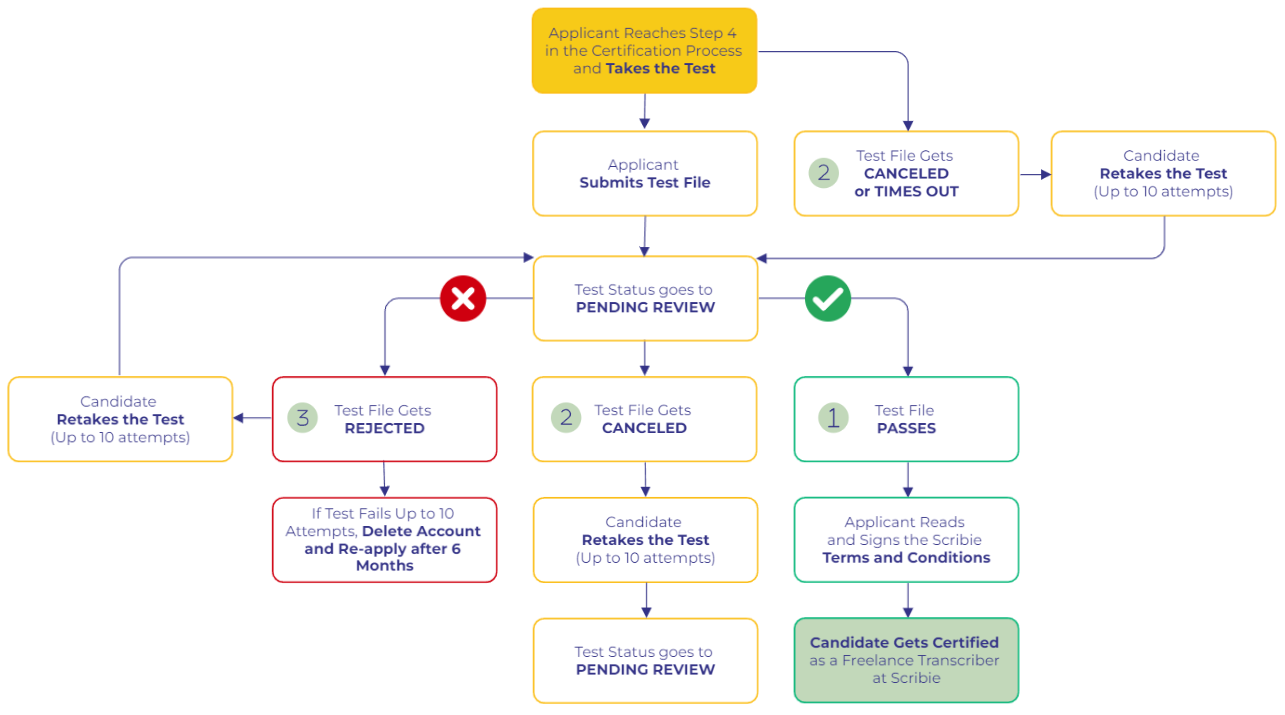
Applicants at Scribie undergo a five-step Certification Process. Only upon successfully clearing the test, which is step 4 in the Certification Process, can applicants achieve certification and begin their roles as freelance transcribers.
Many candidates are curious about the outcome of their tests and the current state of their applications. This article is written to shed light on these queries and other commonly posed questions.
When an applicant reaches step 4 in the Certification process and submits a test file, here’s a brief overview of the process and potential outcomes.

The following sections provide more details about each phase of the process.
When Taking the Test
When you log in to your account, you will be shown the Test tab by default. If there are available test files at the time you log in, these will be listed on that page. If there are no available test files, you will be shown the message that there are none available at that time.
Test files are provided on a first-come, first-served basis thus please select an available test as soon as you can as there are many other candidates waiting for test files to become available. Thus, once you see a test file, quickly click on the preview button (round blue button on the left side of the page) to hear a sample of the audio file. If you can hear the speaker(s) clearly, then click on the Select button on the right side of the page so the test file gets assigned to you.
While working on the test, there may be instances where you find the file too difficult to work on. You have the option to Cancel the test file. However, before doing so, please note that you only have a maximum of 10 attempts. Once you select a test file, it is counted as 1 attempt. So please utilize your attempts wisely. Make sure to hit the preview button multiple times and only select the audio if you are confident about its quality and can grasp the subject being discussed.
Once a file is selected, it counts as an attempt, so we recommend giving it your best shot even if the test file seems challenging, as pushing through can increase your odds of success compared to canceling the file.
After Successfully Submitting a Test
Once your file gets submitted, that is, you receive the pop-up message that your test is successfully submitted and you also receive the email confirmation stating that we have received your test file, then you will see the test marked on your Test History tab as ‘Pending Review’. Please wait for the review to be completed.
After submission, here are the potential subsequent statuses of the test file.
Status 0: Test File Remains Pending Review
When you continue to see that your test file remains at ‘Pending Review’ and the review date keeps changing or shown as elapsed, that means that the file is overdue and we were not able to deliver the file on time. Remember that test files are live customer files. For such cases, the path forward is to just wait since such files are already prioritized to be delivered as soon as we can.
Also, depending on the file (some files are assessed as high difficulty and would require multiple rounds of reviews) the review may be extended, some files are only reviewed 3x while others up to 8x. So please expect the date may still change as it depends on the difficulty level of the file. Normally files (test files and regular files) will be reviewed in a week but for files with audio issues or difficult accents, it may be extended for one week or two, so a file may take around 3 weeks or so.
Please review the Transcription Process for more details on what is done at each stage.
Status 1: You Pass the Test
After passing the test, you’ll receive a confirmation email. Congratulations on becoming a certified freelance transcriber with us!
Status 2: Test File Gets Canceled
Another test result is Canceled. Remember that test files are live customer files so if the customer cancels his/her order, then the test file gets canceled as well.
If you receive the email that the test file “has been automatically canceled since the file has to be returned to the customer and therefore cannot be reviewed or verified”, this means the file was returned to the customer due to audio issues or was canceled by the customer. If this happens, you may retake the test. We cannot control if customers opt to cancel their orders thus we provided 10 attempts so you are covered when this happens.
Status 2: Test File Times Out
One possible test result for test files that are not successfully submitted is Timedout. All files at Scribie, including test files, is subject to time-out rules. If you do not submit the test file on time, it may timeout. If that happens, you may retake the test, up to a maximum of 10 attempts.
You will find detailed information on this in the blog ‘Time Out Rules for Applicants’.
Status 3: Test File Gets Auto Rejected
Sometimes, test files are automatically rejected. These automatic rejections occur when the system detects a number of significant errors, with an accuracy margin of +/-5%. This means that the corrections made didn’t meet the minimum accuracy threshold to pass the test. Our technical team has rigorously tested this algorithm and found it highly accurate.
Once the file is delivered, differences (we call them ‘diffs’) will be available for you to review. The diffs show a comparison of your submission to the QC’ed version of the file. This is shown so you can check where your mistakes are, for continuous improvement.
Status 3: The Test File is Rejected
If your test submission falls short of our accuracy standards, it will be rejected.
We employ a 4-step transcription process, meaning your submission undergoes review, proofreading, and quality control (QC). At least three certified transcribers have evaluated the file, confirming any alterations made. The QC’s decision is the final call on this matter, as they are tasked with guaranteeing the file’s accuracy is 99% or above before it’s delivered to the client.
After You Pass the Test
Once you pass the test, the Scribie Terms and Conditions will be presented to you. We urge you to thoroughly read and understand each clause, especially regarding the confidentiality of accounts and files, as we strictly uphold these terms. We recommend proceeding with signing only if you fully agree with all the stipulations.
After agreeing, you’ll be introduced to the transcriber interface where you are now eligible to pick regular files. While the selection process mirrors that of test files, you’ll notice a greater variety in the regular files available.
After You Fail the Test
After you fail the test, that is, if your test is rejected, canceled, or times out, don’t be disheartened; you have the opportunity to retake the test up to 10 times.
Should you fail all 10 attempts, you’ll need to delete your account and wait 6 months before re-applying. Upon re-application, another 10 attempts will be provided. Please note that this step (the account deletion and 6-month waiting period) cannot be bypassed.
How to Check the Diffs
After the file to which your test file belongs gets delivered, the diffs is then generated. As mentioned above, the diffs, short for differences, show the changes that were made during the review.
In the diff output, green highlights represent additions, while red signifies deletions or changes. It’s important to recognize that not everything highlighted in red or green is deemed a major error; they can represent minor alterations. Major mistakes that impact the grade include mishears, misspellings, soundalikes, and changes that modify the intended meaning.
Please read the blog ‘All You Need to Know About Test Files’ for more details on the grading of test files.
The table below shows the category of changes and their definitions.
| Category | Type | Description |
| Soundalike | Major | Words that sound similar but differ in meaning, e.g., allude and elude. |
| Mishear | Major | The spoken word does not match the typed word. |
| Omission | Major | Words that were spoken but not typed. |
| Misspell | Major | A spelling mistake, e.g., a typographical error. |
| Filler | Minor | Frequently repeated words or phrases, e.g., like. |
| False start | Minor | A phrase followed by an immediate correction. |
| Style change | Minor | A change of style that does not alter the meaning, e.g., percent to %. |
| Subjective change | Minor | Any change which does not alter the meaning. |
FAQs
1 Can I dispute test files?
Test files cannot be disputed. Only once you get certified with us that you can dispute your files.
2 What do the 4 options mean in the diffs?
The four options i.e., diff (approx), raw, reviewed, and reviewed (full) are remnants of the previous grading system. It has now been replaced by the diffs table so you can check the diffs table to see your major mistakes. You will see this once you get certified with us. In the meantime, for applicant accounts, just take a look at ‘Diff (approx)’ so you can see how your work compares to the QC’ed version.
3 Can I retake the same test file?
No, as test files do not repeat. Each test file is unique so once you retake a test, it will be a different file.
4 Since test files are customer files, are test files paid?
Yes, test files that meet our minimum accuracy standards are compensated. However, those that are rejected do not receive payment.
5 Why are rejected test files not paid?
We want to assure everyone that rejected test files are not submitted to our customers, ensuring that we uphold the integrity of the examination process. Our commitment is to maintain transparency and fairness. Rejected files are required to be redone to meet our quality standards before submission to customers. Even passing test files are not sent directly to customers either, as passing test files are raw transcription files and will undergo review, proofreading, and QC. Only QC’ed files are sent to customers.
Since rejected test files do not meet our accuracy standards, these files will not receive payment. This principle applies not just to test files but to regular files as well.


I appreciate having this venue when times are hard.